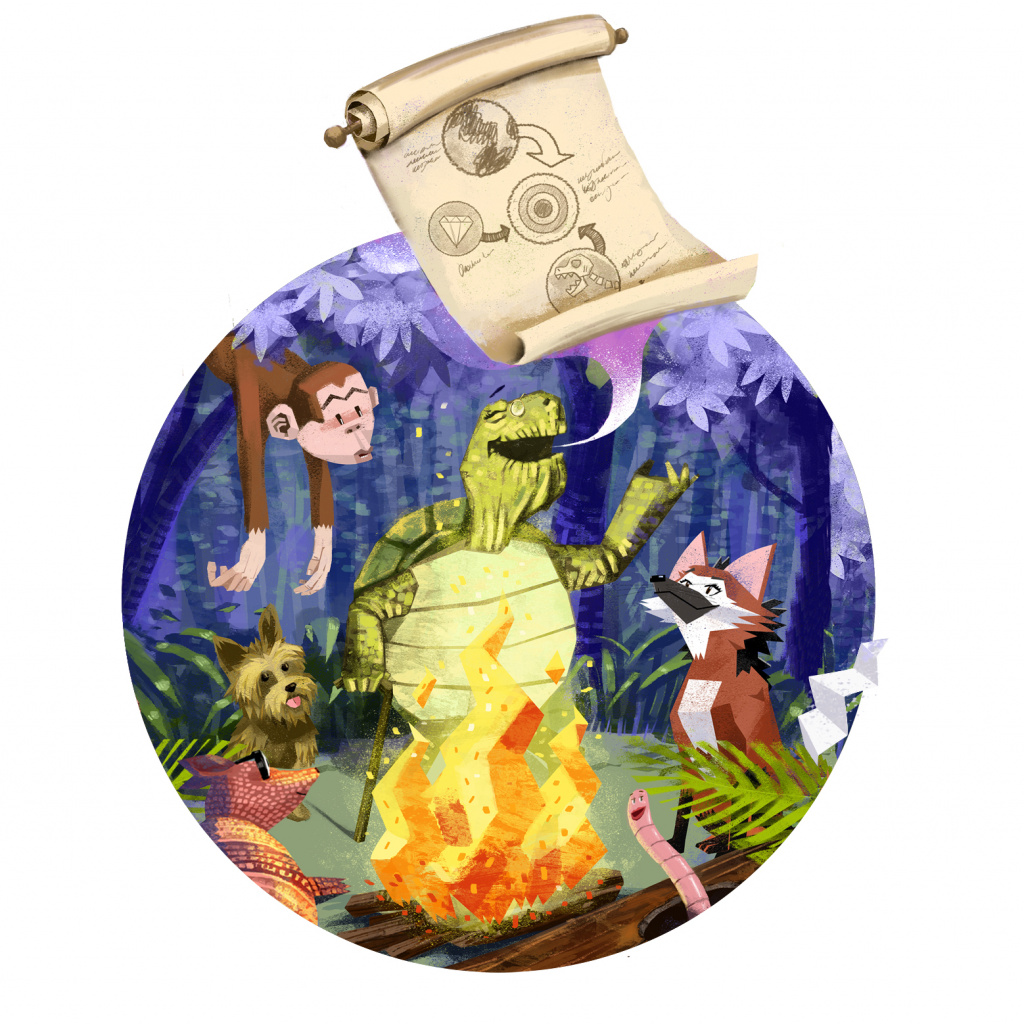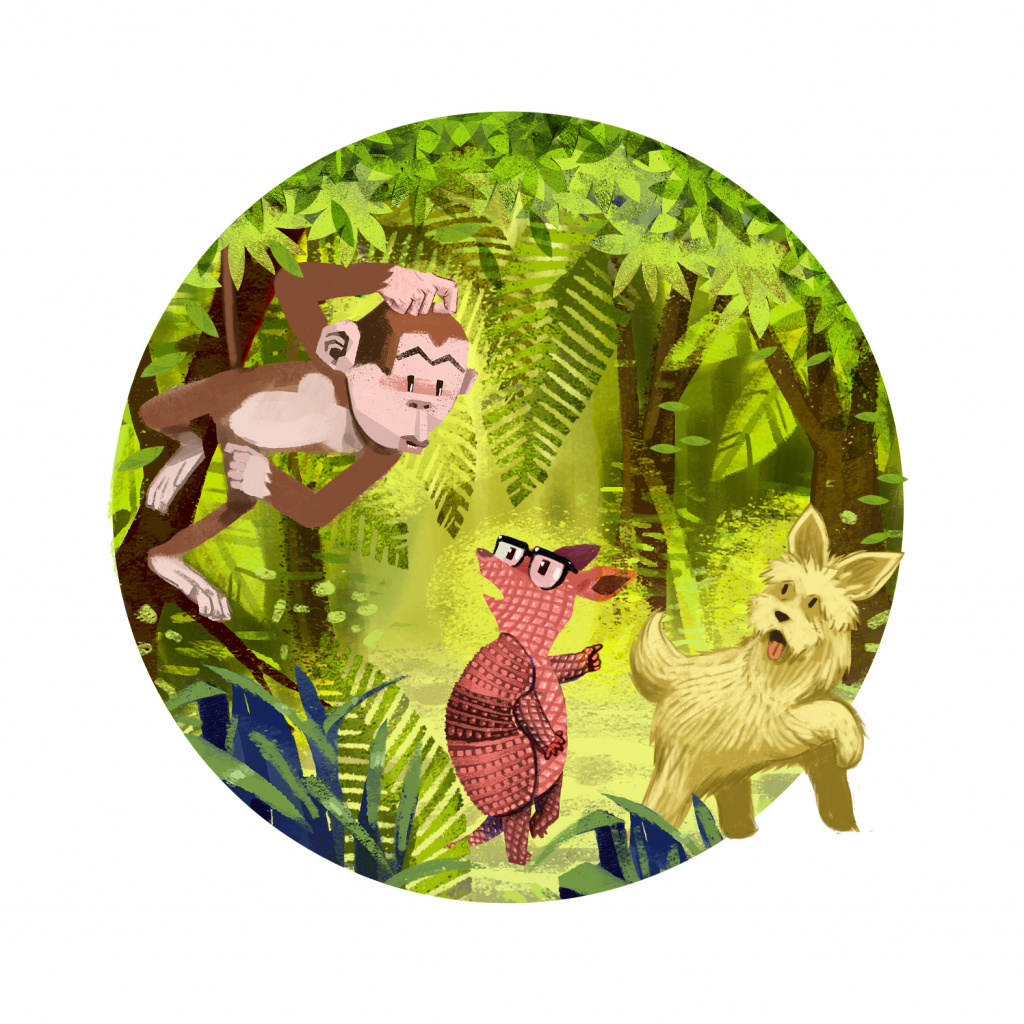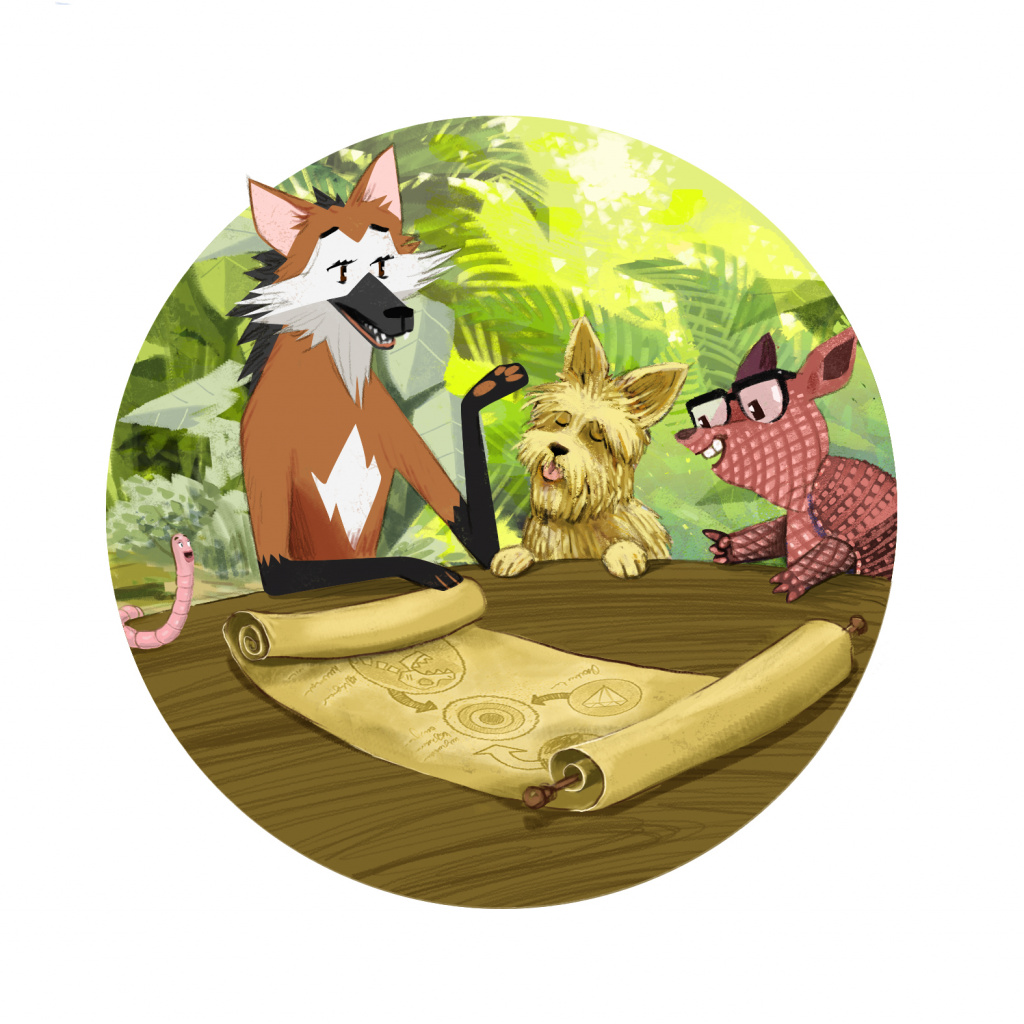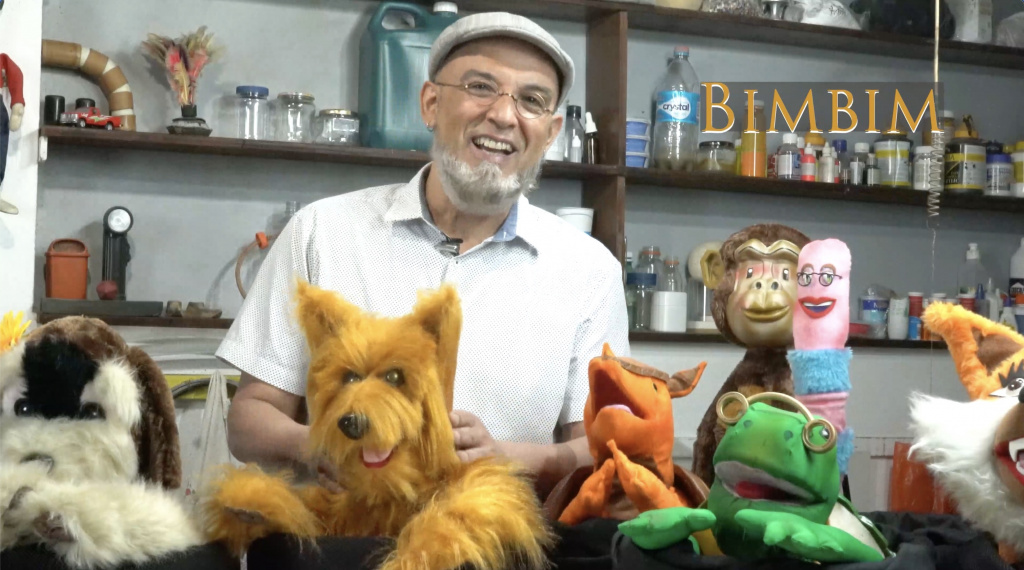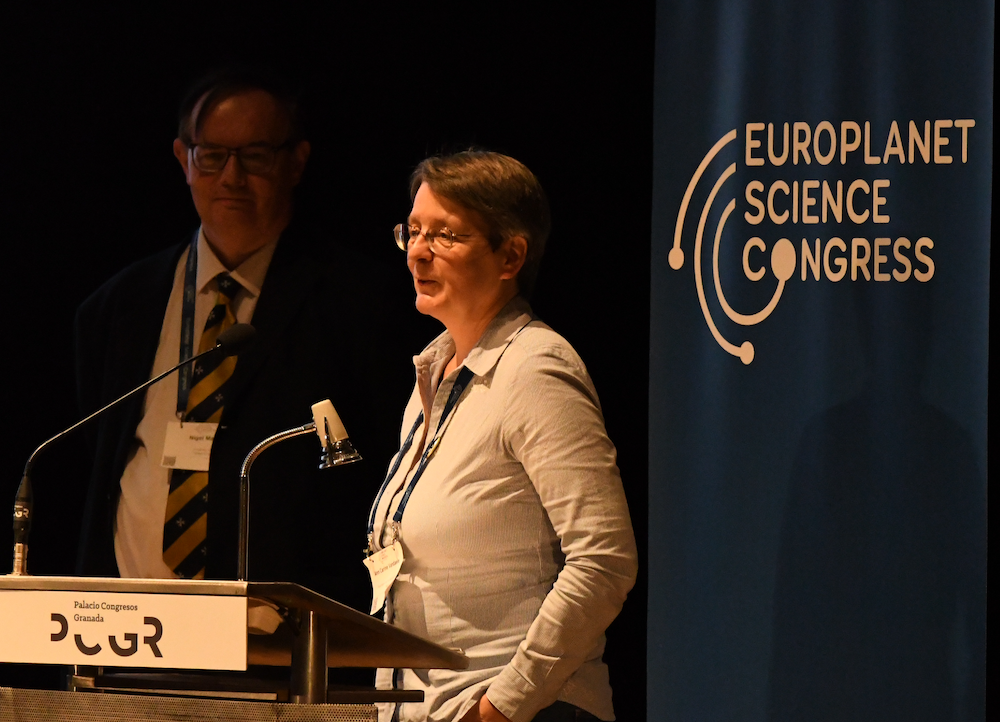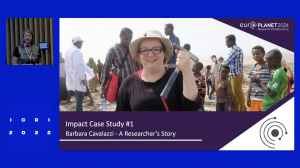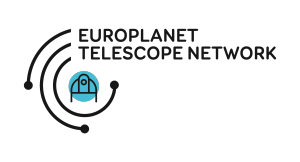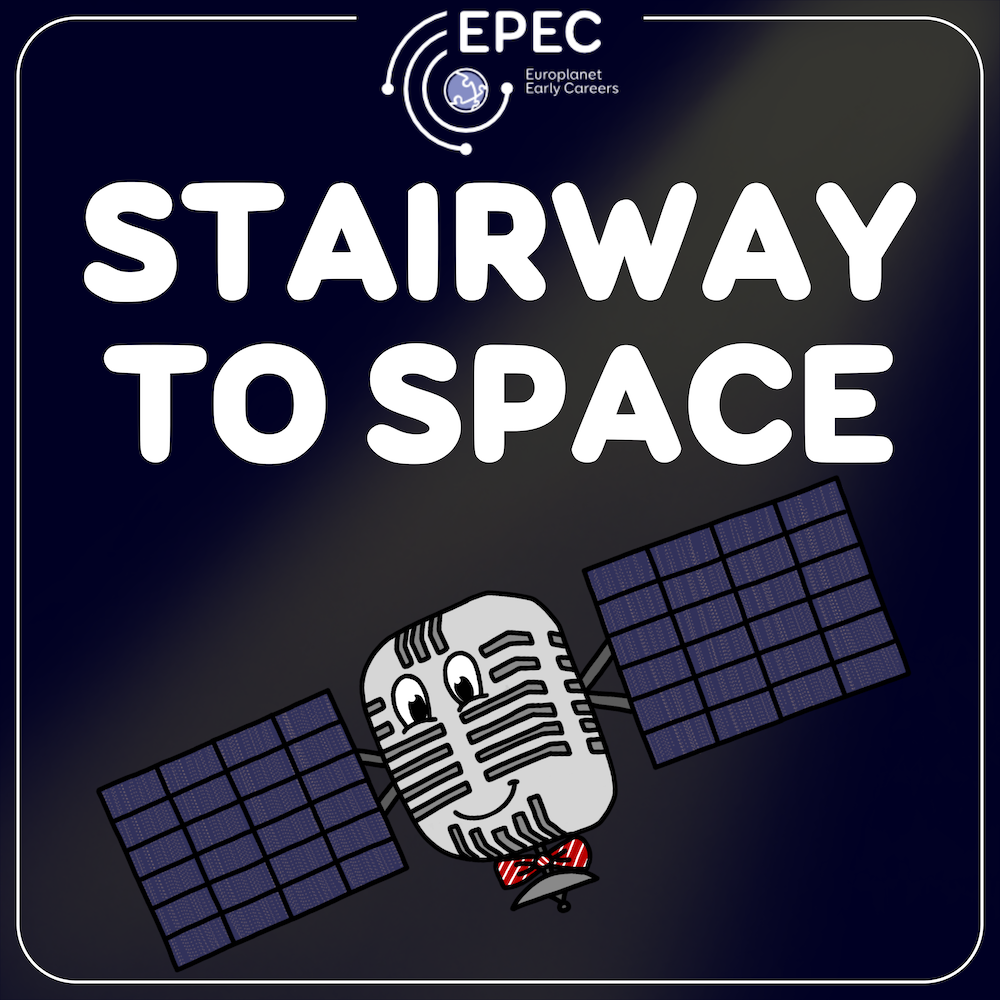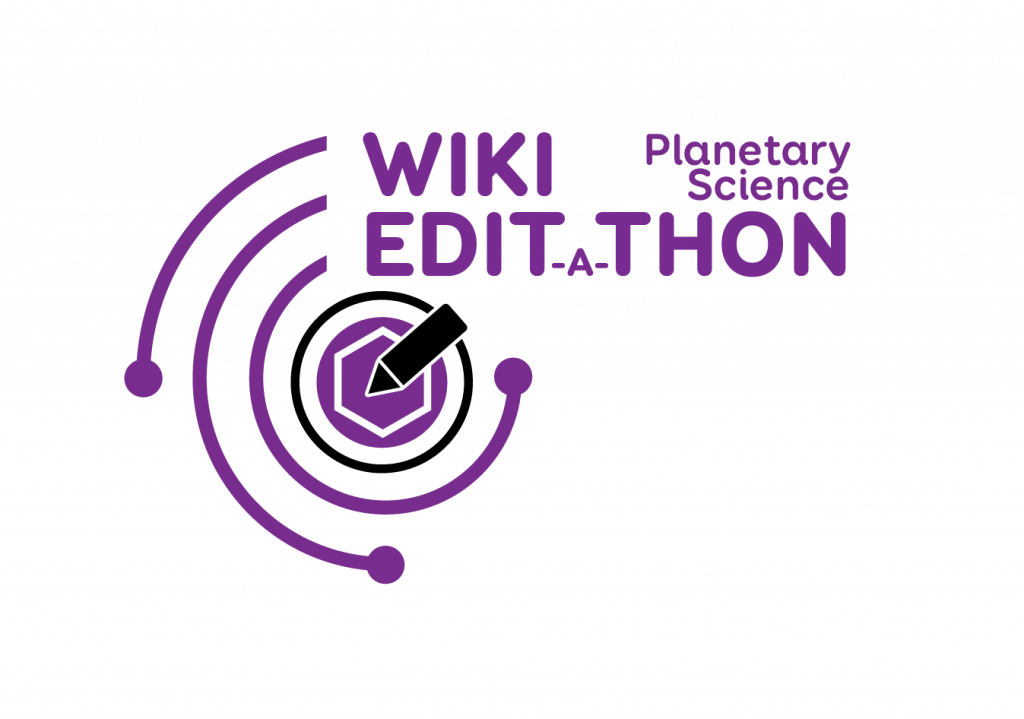
Recent months have provided the first opportunities since the pandemic for the planetary community to meet face-to-face, as well as continued activities online.
Europlanet News | EPSC20222 News | EPEC News | Community News
The Europlanet Society’s New President Elect
Read article in the fully formatted PDF of the Europlanet Magazine.
Congratulations to Ann Carine Vandaele, whose election as the second President of the Europlanet Society was announced at the Europlanet General Assembly in Granada on 22 September. She will take up the role in September 2023 when the term of office of the inaugural President, Nigel Mason, comes to an end.
Ann Carine is Head of Planetary Atmospheres Research Unit at the Royal Belgian Institute for Space Aeronomy. She has been active in the Europlanet Society since its foundation in 2018, serving as Vice- President on the Executive Board and the Chair of the Benelux Regional Hub. Her scientific interests include the development of remote sensing instruments and radiative transfer modelling in planetary atmospheres, and she is involved in several space missions, such as Mars and Venus Express, ExoMars Trace Gas Orbiter (TGO), Juice, Ariel and EnVision.
Her primary motivations as President will be to promote collaboration and interaction between researchers, and to support diversity, inclusion and widening participation in the planetary community. In particular, she is committed to encouraging links between education, research and industry to increase the visibility and the impact of planetary science. She believes strongly that the Europlanet Society has a valuable role to play as an active interlocutor that can represent the planetary community in engaging with decision makers, like the European Space Agency or the European Commission.
Find out more about Ann Carine in this issue’s Planetary Perspectives interview.

Geology and Planetary Mapping Winter School 2023
Read article in the fully formatted PDF of the Europlanet Magazine.
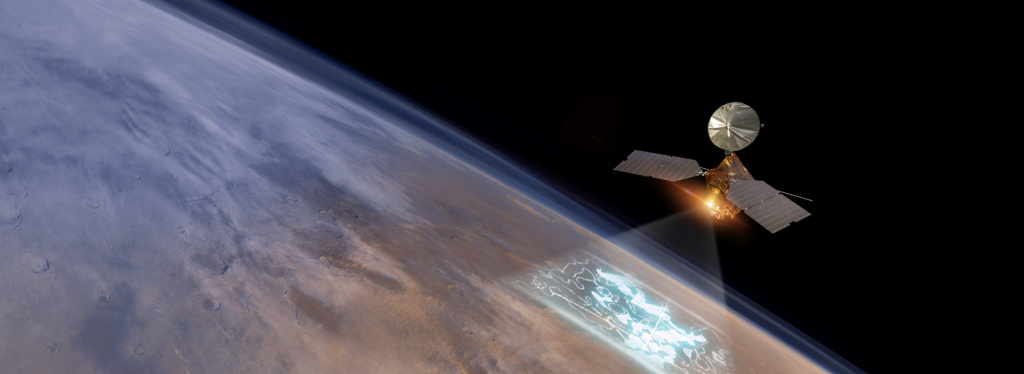
The third edition of the Geology and Planetary Mapping Winter School will be held online from 30 January – 3 February 2023. The Winter School is organised by the Geological Mapping (GMAP) activity of the EU-funded Europlanet 2024 Research Infrastructure (RI) project. The 2023 edition will be largely hands-on, with a programme that includes live seminars and time for asynchronous interaction and mapping work. Registration is free and the deadline for signing up is 10 January 2023. Videos and other resources from the 2020 and 2021 Winter Schools are now available online at the Winter School website: https://www.planetarymapping.eu

Workshop on Earth Observation Techniques and Data Analysis
Read article in the fully formatted PDF of the Europlanet Magazine.
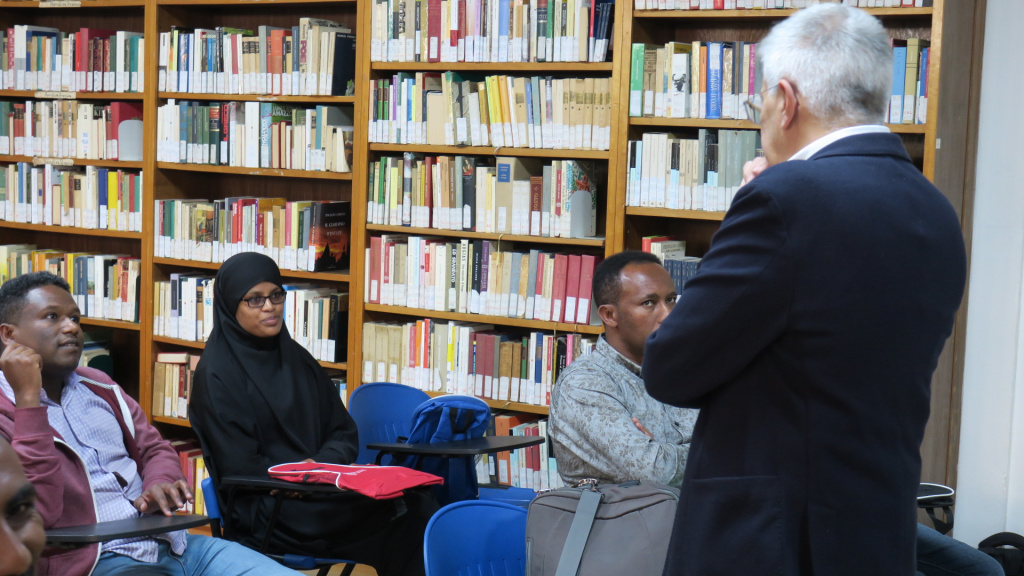
A workshop on ‘Applications of Earth Observation Satellite Data’ took place in Addis Ababa , Ethiopia, from 13-16 December 2022, bringing together 34 space technology specialists, scientists and students to discuss current topics in this rapidly developing field. The workshop was the second in a series organised by Europlanet 2024 RI that aims to support the creation of an African network in planetary science.
The course provided both theoretical knowledge and practical skills in Earth Observation techniques and their applications in Geographical Information Systems (GIS). Students learned about Earth Observation missions, with a particular emphasis on the EU’s Copernicus programme. They were trained in using remote sensing imagery from satellites to derive qualitative and quantitative information about landscapes at urban, basin and regional scales. Students also developed practical skills in processing Earth Observation data and thematic map generation. A further 65 school students took part in a hands-on lab ‘Light up the Constellation’ organised by INAF.

Third Call for Transnational Access

Read article in the fully formatted PDF of the Europlanet Magazine.
Over 100 applications have been submitted in the third Transnational Access Call of the Europlanet 2024 Research Infrastructure (RI) project. Transnational Access supports travel and accommodation costs for European and international researchers to visit over 40 planetary simulation facilities, analysis laboratories and analogue field sites in Europe and around the world. The successful applications will be announced in early 2023.

Europlanet Case Studies at ICRI
Read article in the fully formatted PDF of the Europlanet Magazine.
At the International Conference on Research Infrastructures (ICRI) at Brno in the Czech Republic, Europlanet was invited to present case studies of the impact of its Transnational Access programme and participate in a panel discussion. ICRI is a biannual event, organised jointly by the European Commission and the host country, that brings together about 500 delegates to discuss topics concerning research infrastructures at an international level. Europlanet also co-organised a side event on sustainability of distributed research infrastructures (page 39).

Apply for time on the Europlanet Telescope Network
Read article in the fully formatted PDF of the Europlanet Magazine.
The Europlanet Telescope Network has a rolling call for proposals for observations. Decisions are made within two months of submission. For further information and how to apply, see the Europlanet Telescope Network webpage.

Expert Exchange Programme
Read article in the fully formatted PDF of the Europlanet Magazine.
Europlanet 2024 RI’s Expert Exchange Programme aims to support the planetary community to share expertise and best practice, and to prepare new facilities and services. The programme provides funding for short visits of up to one week. The next deadline for applications is 31 December for visits to take place between 1 February and 31 July 2023. Read about an Expert Exchange visit in the feature on page 34.

The Europlanet Science Congress (EPSC) 2022
Read article in the fully formatted PDF of the Europlanet Magazine.
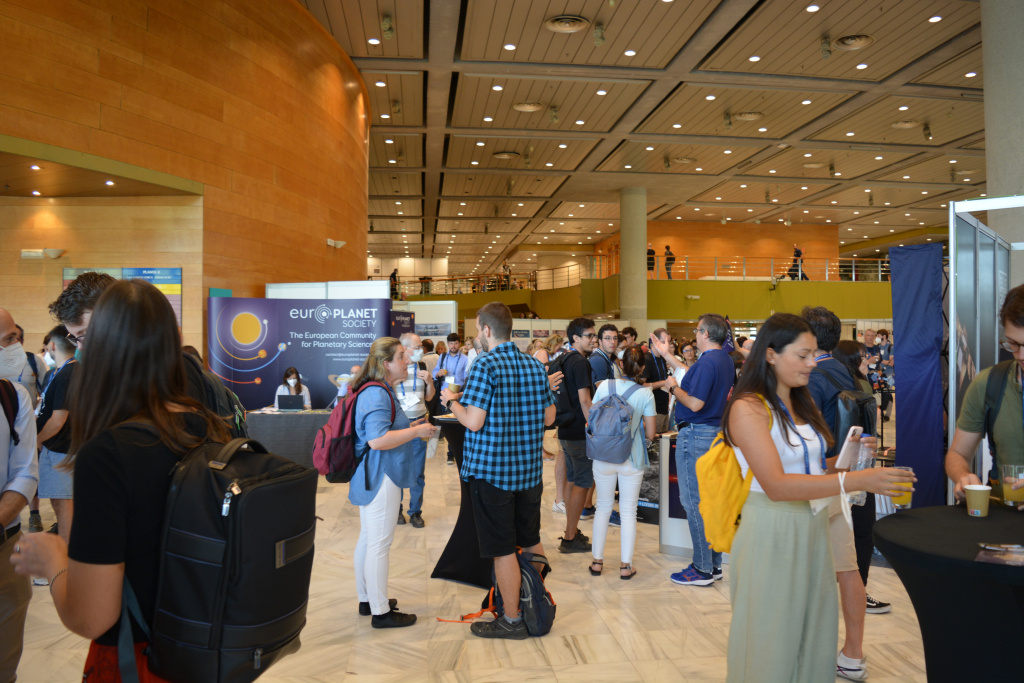
Almost 1200 members of the international planetary community gathered in Granada, Spain, from 18-23 September for the Europlanet Science Congress (EPSC) 2022. The meeting, which was held jointly with the European Astrobiology Network Association (EANA), was the first in-person EPSC since 2019 and was one of the largest meetings on planetary science to take place in Europe to date.
The Europlanet 2024 RI project and EANA supported 209 bursaries at a value of €118,660, covering abstract and registration fees and providing travel grants for early career participants, researchers from under-represented countries, amateur astronomers and teachers.
The programme for EPSC2022 included 733 oral presentations and 420 posters, with over 100 scientific parallel sessions, community events, early career events and interactive workshops. Innovations for 2022 included thematic debates and discussions with journal editors, as well as elements successfully trialled during the virtual meetings in 2020-2021, such as keynote lectures, morning briefings and session recordings.
Community events included Agency Night, with representatives from ESA, NASA, the European Strategy Forum on Research Infrastructures (ESFRI), presentations on the US Decadal Strategy for Planetary Science and Astrobiology 2023-2032, and a multi-agency dialogue on ‘A New Decade of Venus Exploration’.
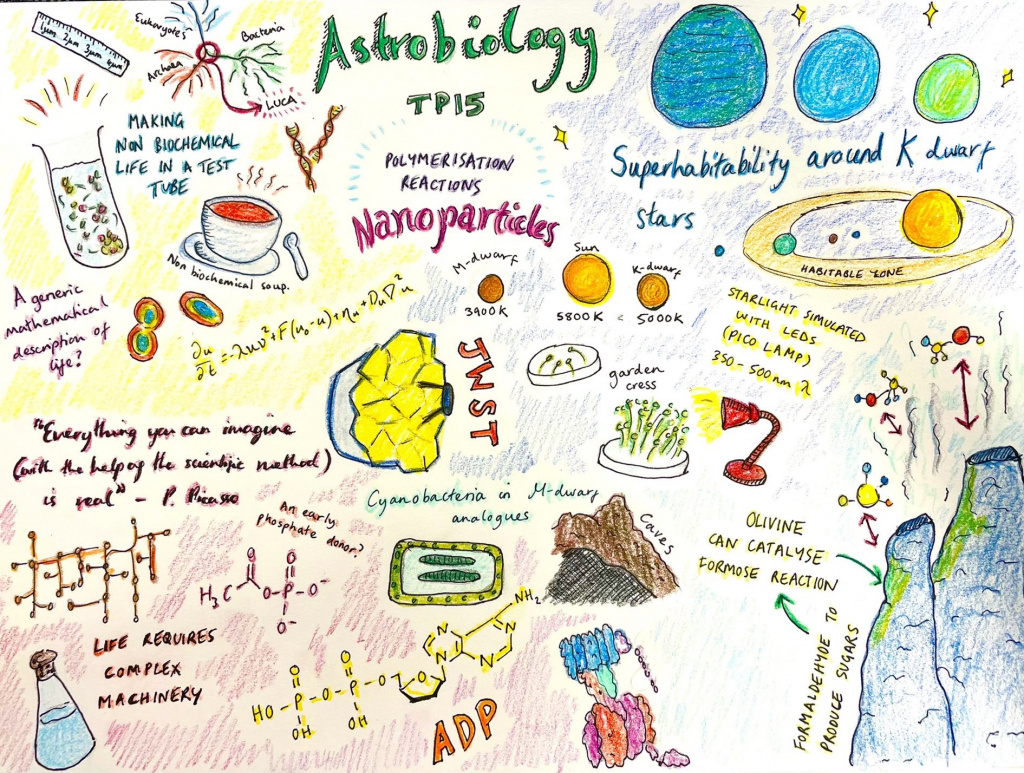
Beyond the conference centre, planetary science infused Granada, thanks to the support of the Local Organising Committee. Restaurants around the city centre offered tapas inspired by planetary objects as part of a ‘Gastro Tour of the Solar System’. An educational outreach programme, organised in collaboration with Lecturers Without Borders, involved 18 EPSC participants visiting 12 schools and reaching around 360 students in the local community (see page 46).
Europlanet thanks all the EPSC organising committees, conveners, session chairs and Copernicus for making EPSC2022 a memorable event. See EPSC2022 in pictures feature on page 20.
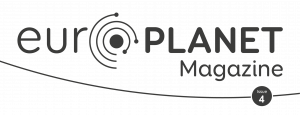

News from EPSC2022
Read article in the fully formatted PDF of the Europlanet Magazine.
EPSC2022 was a treasure-trove of science that attracted the attention of journalists around the world. A press briefing on NASA’s Double Asteroid Redirection Test (DART) spacecraft highlighted the contributions by ESA’s upcoming Hera mission, the Italian LICIACube mission and ground-based campaigns to observations of the effects of DART’s impact with the asteroid, Dimorphos (see article on page 34). The first image and spectra of Mars from the NASA/ESA/CSA James Webb Space Telescope (JWST) were also presented at the meeting (see article on page 44).
Over the course of the meeting, the EPSC2022 press office issued news releases on a wide range of planetary science topics. Here is a round-up:

Read article in the fully formatted PDF of the Europlanet Magazine.
Star Light Simulator Illuminates the Search for Life Around the Milky Way’s Most Common Stars
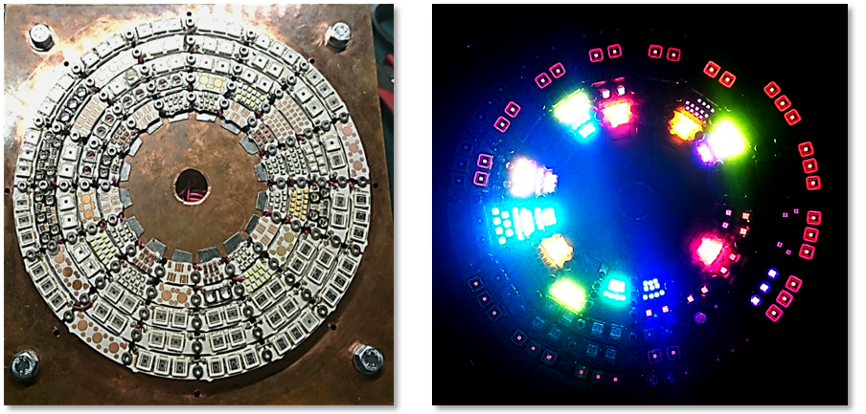
Italian researchers have demonstrated experimentally, for the first time, that microorganisms can photosynthesise using the infrared-dominated light emitted by the most common type of star in the Milky Way. The Star Light Simulator can generate light intensities and spectra at different ranges to reproduce the light for any star. At EPSC2022, Nicoletta La Rocca (University of Padua) presented an experimental set-up that simulated the effect of light emitted by the smallest type of hydrogen-burning star, known as a red M-dwarf, on an artificial planetary environment. The results suggest that these stars could support oxygen-rich worlds inhabited by complex organisms. Full press release.

Read article in the fully formatted PDF of the Europlanet Magazine.
Earth-like Exoplanets Unlikely To Be Another ‘Pale Blue Dot’
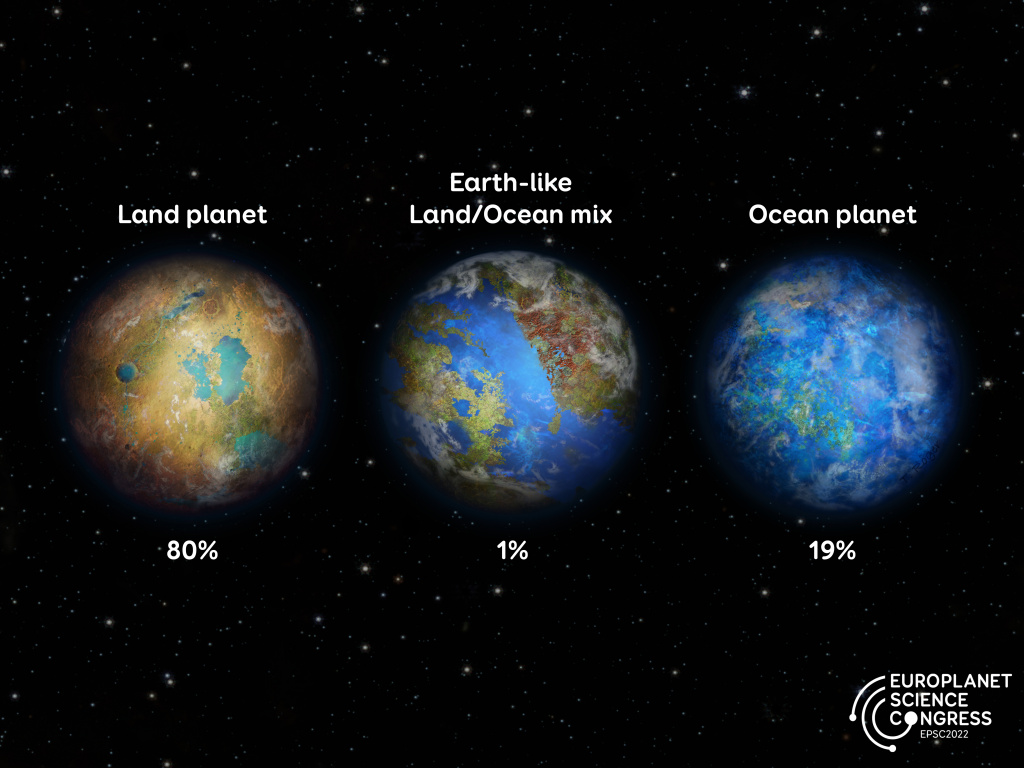
When searching for Earth-like worlds around other stars, instead of looking for the ‘pale blue dot’ described by Carl Sagan, new research suggests that a hunt for dry, cold ‘pale yellow dots’ might have a better chance of success. The near balance of land-to-water that has helped life flourish on Earth could be highly unusual, according to a study by Tilman Spohn and Dennis Höning presented at EPSC2022. By modelling how the evolution and cycles of continents and water could shape the development of terrestrial exoplanets, the researchers demonstrated that planets have approximately an 80 percent probability of being mostly covered by land, with 20 percent likely to be mainly oceanic worlds. Barely one percent of the outcomes had an Earth-like distribution of land and water. Full press release.

Read article in the fully formatted PDF of the Europlanet Magazine.
First 3D Renders From JunoCam Data Reveal “Frosted Cupcake” Clouds On Jupiter
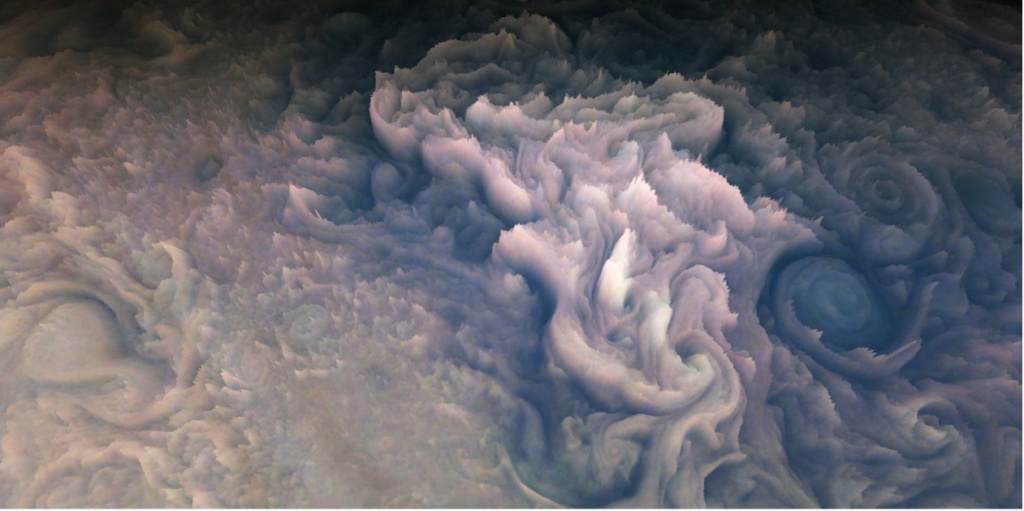
An animation of the relative heights of the cloud tops of Jupiter reveals delicately textured swirls and peaks that resemble the frosting on top of a cupcake. The animation used data derived from JunoCam, a visible-light camera onboard NASA’s Juno spacecraft, which has been orbiting Jupiter since 2016. The results were presented at EPSC2022 by Gerald Eichstädt, a professional mathematician and software developer, who is part of a worldwide team of citizen scientists that work on JunoCam data in collaboration with professional astronomers and the Juno mission team. Full press release.

Read article in the fully formatted PDF of the Europlanet Magazine.
Planetary-scale ‘heat wave’ discovered in Jupiter’s atmosphere
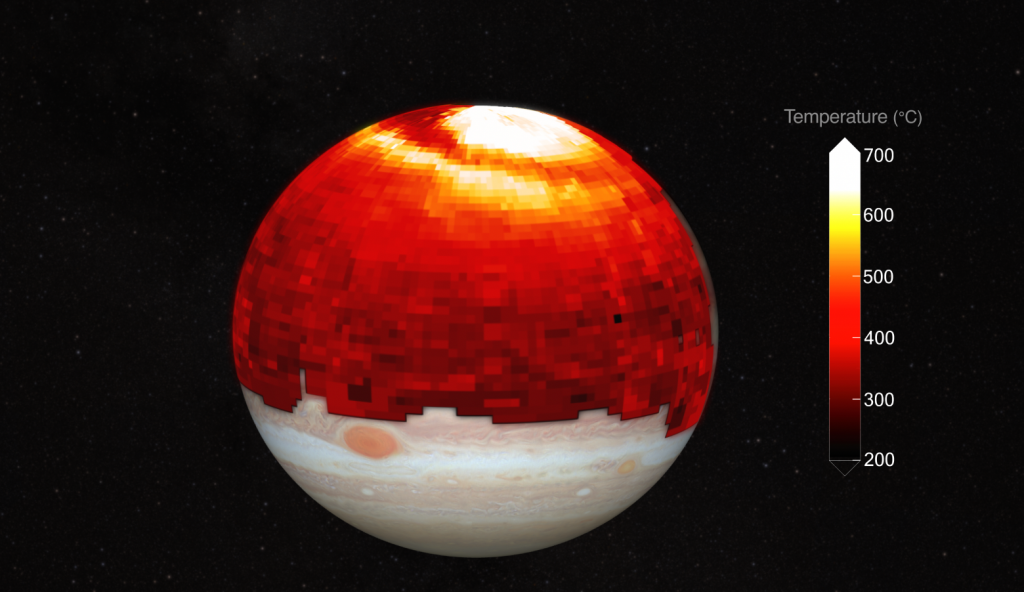
An unexpected ‘heat wave’ of 700 degrees Celsius has been detected in Jupiter’s atmosphere. The feature was presented at EPSC2022 by James O’Donoghue (JAXA). It occured just below the northern aurora, extending 130,000 kilometres and travelling towards the equator at a speed of thousands of kilometres per hour.
Just like Earth, Jupiter experiences auroral light-shows around its poles as an effect of the solar wind. However, while Earth’s auroras are transient and only occur when solar activity is intense, auroras at Jupiter are permanent and have a variable intensity. These powerful auroras can heat the region around the poles, and winds can redistribute the heat globally around Jupiter. The heat wave, was most likely triggered by a pulse of enhanced solar wind plasma impacting Jupiter’s magnetic field, which boosted auroral heating and forced hot gases to expand and spill out towards the equator. Full press release.

EXPLORE Data Challenge 2022 Winners
Read article in the fully formatted PDF of the Europlanet Magazine.
The 2022 EXPLORE Lunar Data Challenges, launched at EPSC2022, invited lunar enthusiasts of all ages to identify hazards on the Moon’s surface and plot a safe journey for a rover across the lunar surface. The region featured in the Challenge, the Archytas Dome, is close to the Apollo 17 landing site where the last humans set foot on the Moon 50 years ago.
The winners are: Isabella Claire Adriani, Lewis Lovell and Freja Thoresen (Machine Learning Challenge) and Shantibala Singha, Serge Paupy and students from Lycée Français International Molière, Karol Sawick, Stavros Sklavenitis and Julia Krzyżaniak(Public Challenge).
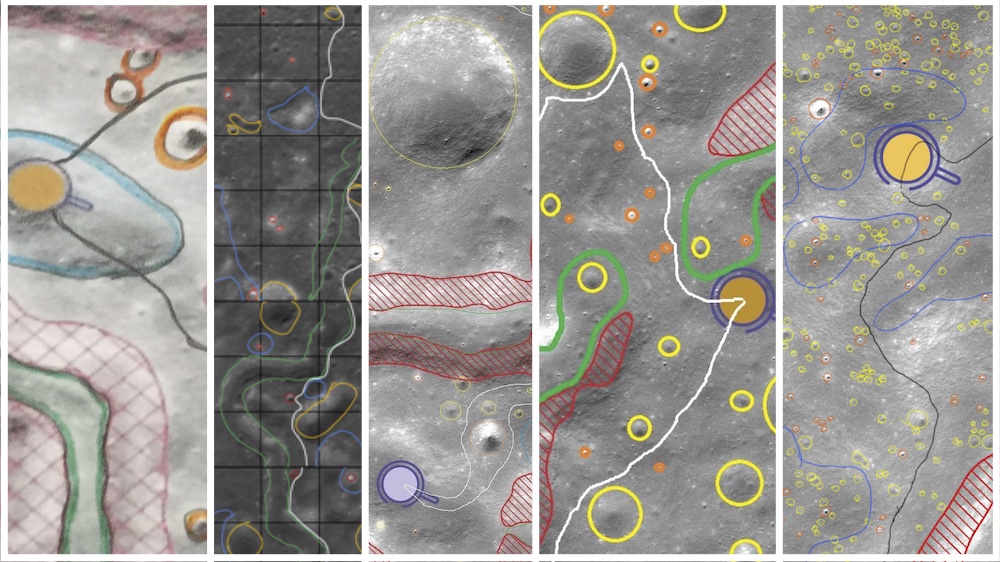
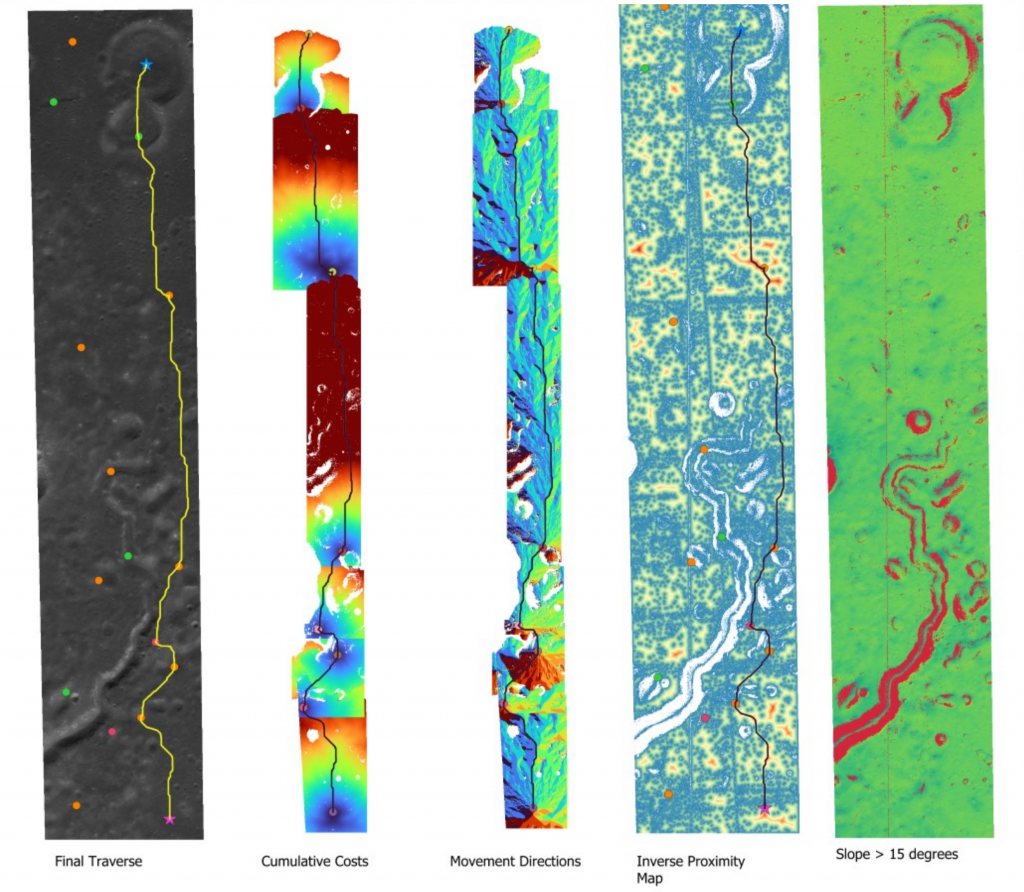

Read article in the fully formatted PDF of the Europlanet Magazine.
Four-legged Jumping Robots LEAP to Explore the Moon
Institute for Solar System Research) showed how a four-legged robot, trained through artificial intelligence, has learned the same lesson as the Apollo astronauts – that jumping can be the best way to move around on the surface of the Moon.
LEAP (Legged Exploration of the Aristarchus Plateau) is a mission concept by a consortium from ETH Zurich, the Max Planck Institute for Solar System Research, OHB, the University of Münster, and the Open University, which aims to explore some of the most challenging lunar terrains. The LEAP team is working towards the robot being integrated on ESA’s Argonaut European Large Logistic Lander, which is scheduled to land on the Moon multiple times from the late 2020s to the early 2030s. Full press release.

ExoClock Counts Down Ariel Exoplanet Targets
Read article in the fully formatted PDF of the Europlanet Magazine.
Details of the orbits of 450 exoplanets, all potential observation targets for ESA’s Ariel space mission, were presented at EPSC2022 by the ExoClock project team. A paper summarising the results, co-authored by 217 researchers, amateur astronomers, university students and high school pupils, has been submitted for publication in the Astrophysical Journal Supplement Series.
Ariel will study a population of more than 1000 exoplanets to characterise their atmospheres. Participants in the ExoClock project submit measurements known as ‘light curves’, which show the drop in intensity as an exoplanet ‘transits’ or passes in front of its host star and blocks some of the light. When Ariel launches in 2029, it will need to have precise knowledge of the expected transit time of each exoplanet that it observes, in order to maximise the mission’s efficiency and impact. The ExoClock results demonstrate that observations by amateur astronomers using their own telescopes can contribute to real science and have a high impact for a mission. Full press release.

Read article in the fully formatted PDF of the Europlanet Magazine.
First Probable Impact Crater Discovered in Spain
A probable impact crater has been discovered in the province of Almeria in southern Spain. While around 200 impact structures have been identified around the world, this is the first time that signs of a crater have been found on the Iberian Peninsula. The study,presented at EPSC2022 by Juan Antonio Sánchez Garrido (University of Almeria), is the result of 15 years of research by an international team of scientists from the University of Almeria, the Astrobiology Center of Madrid, the University of Lund and the University of Copenhagen. The impact event, which probably occurred around 8 million years ago, formed a crater about 4 kilometres in diameter, and is surrounded by a larger structure about 20 kilometres across where the impact caused the sedimentary strata to collapse. Full press release.
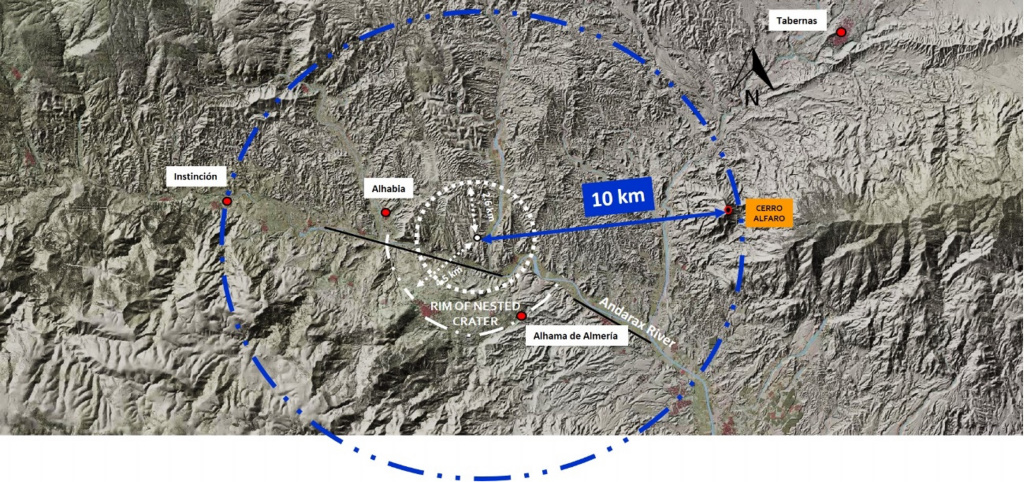

Read article in the fully formatted PDF of the Europlanet Magazine.
Big planets get a head start in pancake-thin nurseries
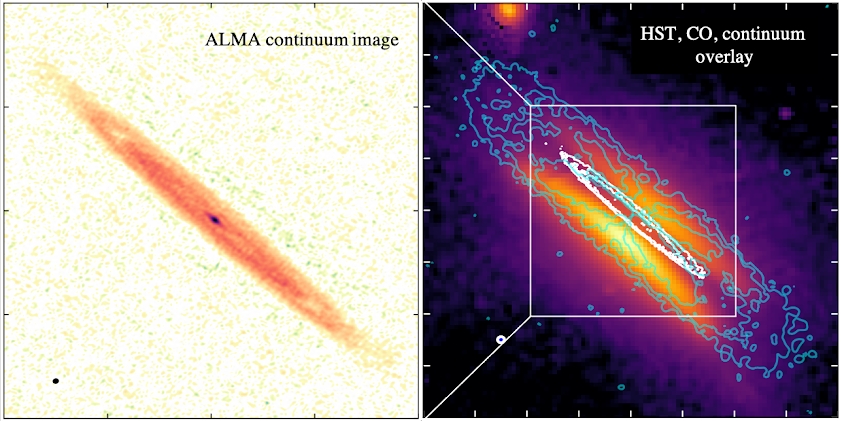
Super-thin planet nurseries have a boosted chance of forming big planets, according to a study presented by Marion Villenave (NASA-JPL) at EPSC2022. High resolution images of a remarkably thin disc of dust and gas around a young star showed that its structure accelerated the process of grains clumping together to form planets. Further studies of thin discs might help provide more insights into the dominant mechanisms for how wide-orbit planets form, a field of research where there are still many open questions. Full press release.

Read article in the fully formatted PDF of the Europlanet Magazine.
Virtual Hiking Map for Jezero Crater, the Mars 2020 Perseverance Rover Landing Site
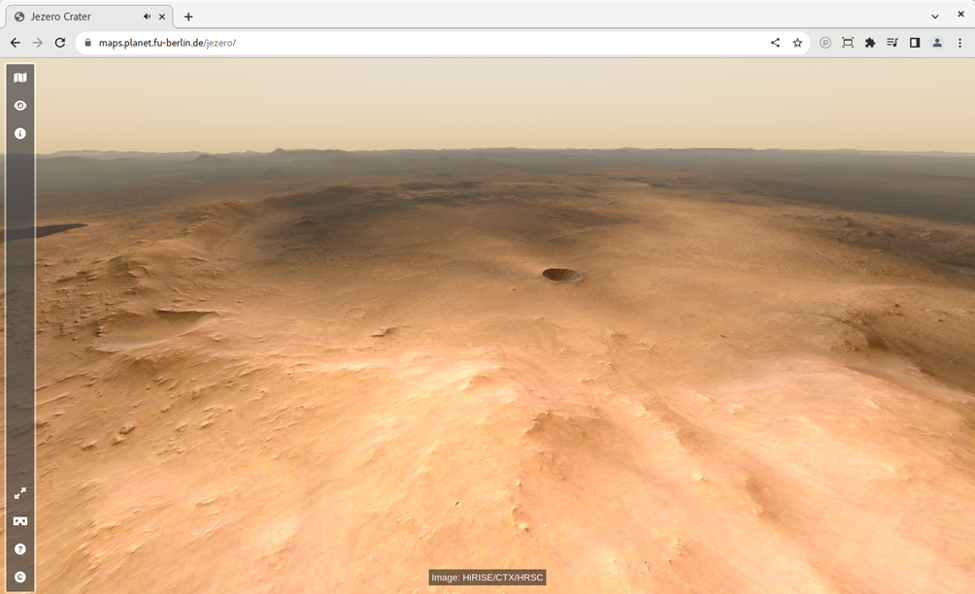
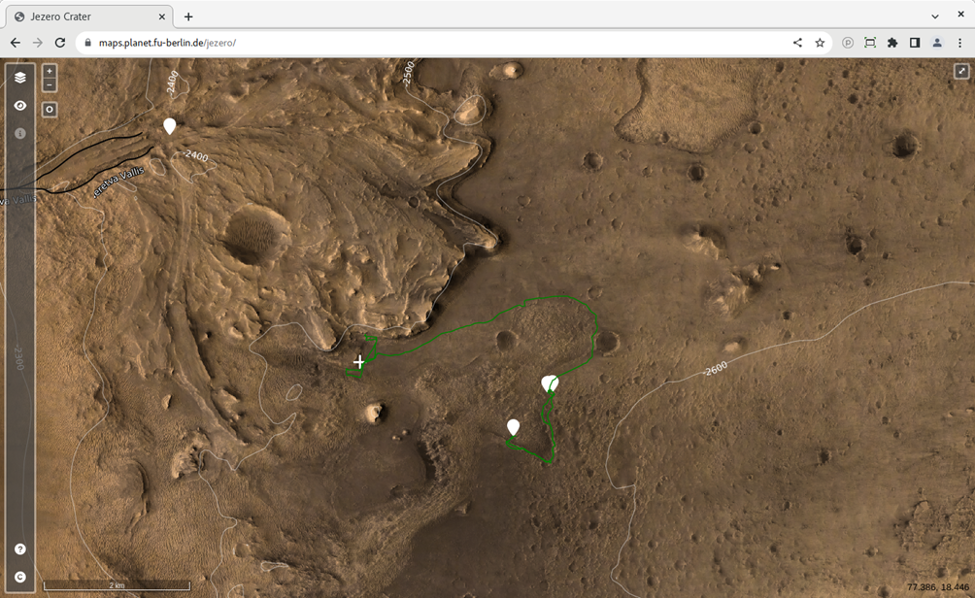
Prospective Mars explorers can now take a hike around the landing site of NASA’s Mars 2020 Perseverance rover with an interactive map. The map, presented at EPSC2022 by Sebastian Walter (Freie Universität Berlin), can be accessed through a normal web browser and is loaded with orbital imagery and terrain data, as well as synthetic and real 3D panoramic views of Jezero crater and its surrounding area. https://maps.planet.fu-berlin.de/jezero

Read article in the fully formatted PDF of the Europlanet Magazine.
Farinella Prize 2022
Julie Castillo-Rogez, a planetary scientist working at NASA’s Jet Propulsion Laboratory (JPL) in California (USA), and Martin Jutzi, a physicist working at the Physics Institute of the University of Bern
(Switzerland), have been awarded jointly the 2022 Paolo Farinella Prize for their outstanding contributions to the field of ‘Asteroids: Physics, Dynamics, Modelling and Observations’.
Dr Castillo-Rogez has made significant contributions to the understanding of the physical and chemical evolutions of small and mid-sized Solar System bodies. Her work was critical to the success of the Dawn mission at the dwarf planet Ceres. Dr Jutzi has played an important role in the study of collisional processes involving bodies ranging from asteroid-sized to planetary scale. In particular, he developed a state-of-the-art Smoothed Particle Hydrodynamic (SPH) code especially suited to studying how collisions occur among small bodies.
The annual prize was established in 2010 to honour the memory of the Italian scientist Paolo Farinella (1953-2000). The winners received their awards during EPSC and gave 20-minute prize lectures. Full press release.

Read article in the fully formatted PDF of the Europlanet Magazine.
Europlanet Prize for Public Engagement 2022
The 2022 Europlanet Prize for Public Engagement has been awarded to Kosmas Gazeas and the team behind the ‘Planets In Your Hand’ tactile exhibition. ‘Planets In Your Hand’ is an interactive set of models of planetary surfaces. Constructed in portable square frames, the exhibition gives a multisensory impression of the wide variety of surface characteristics and environmental properties of the planets in our Solar System.
Although suitable for people of all ages, the models have been specifically designed for visually impaired audiences. Since 2017, ‘Planets in Your Hand’ has travelled to schools, universities and private institutes and organisations, reaching thousands of visitors to date.
The award was presented during EPSC2022 in Granada (on behalf of the team) to Dimitrios Athanasopoulos, who gave a 20-minute prize lecture. The team has also received a cash award of €1500. Full press release.

Europlanet Early Careers (EPEC) News
Read article in the fully formatted PDF of the Europlanet Magazine.
The Europlanet Early Career (EPEC) network organised a ‘bouquet’ of activities for early careers at EPSC2022, including contests, short courses and social events.

Read article in the fully formatted PDF of the Europlanet Magazine.
Science Flash 2022
Read article in the fully formatted PDF of the Europlanet Magazine.
Science Flash was back as an in-person event at EPSC2022. Early career researchers were challenged to give a three-minute presentation featuring three non-text images plus any supporting material to quickly introduce a scientific topic in a creative and engaging way. First prize and a free registration for an upcoming EPSC went to Alessandro Pisello, with Johannes Brötzner as runner up and Noah Molinski in third place receiving Science Flash mugs.

Read article in the fully formatted PDF of the Europlanet Magazine.
Outstanding Poster Competition at EPSC2022
The Outstanding Poster Competition at EPSC2022 attracted 64 entries, and 44 conference participants took time out of their schedules to act as the contest judges. Six winners were selected, who each received a certificate and the option of a free registration for either the DPS-EPSC Joint Meeting 2023 in San Antonio, USA, or EPSC2024 in Helsinki, Finland. The winners are Amy Dugdale (Impact generated modification of the mineralogy at Oxia Planum), Lucy Wright (Stratospheric HCN and Evolution of a Mixing Barrier in Titan’s Equatorial Region from Low-Resolution Cassini/CIRS Spectra), Nikolaj Dahmen (A Deep Catalogue of Marsquakes), Amy Tuson (A Search for Long-Period Transiting Exoplanets with TESS and CHEOPS), Ana de Dios Cubillas (Abiotic clathrite synthesis from CO2-clathrate under ocean world conditions) and Cem Berk Senel (Hypervelocity impact simulations of DART on asteroid Dimorphos: Impact-generated porosity and gravity anomalies).

Read article in the fully formatted PDF of the Europlanet Magazine.
#PlanetaryScience4All EPEC-EPSC Video Contest 2022
Cai Stoddard-Jones, a first year PhD student at Cardiff University, has won the 2022 edition of the #PlanetaryScience4All EPEC-EPSC Video Contest, which challenges early career researchers to showcase their work in a four-minute film. Cai’s winning film presents Comet 29P and the Comet Chasers project. The unusual activity of Comet 29P is still poorly understood despite being the most observed comet to date. The ‘Comet Chasers project’ in Wales supports school children to learn about cometary science and take their own images of comets for use by researchers.
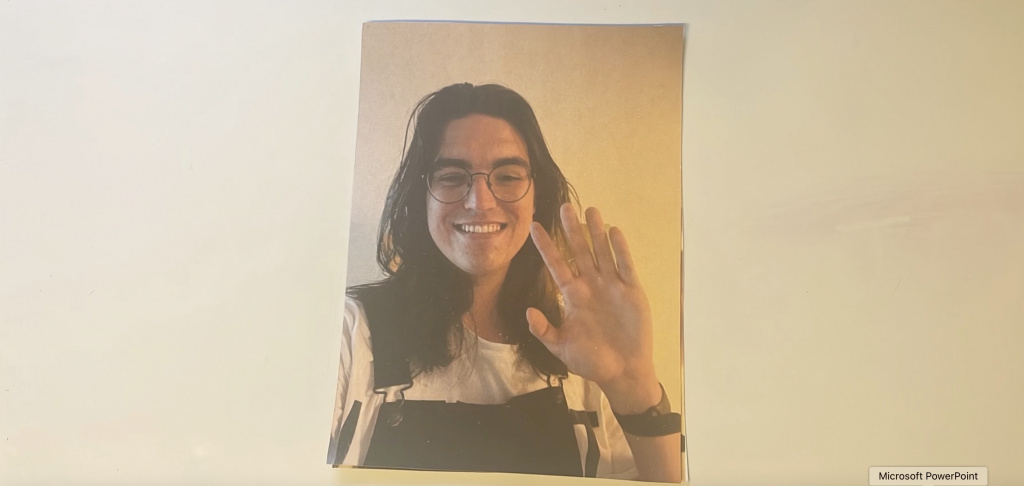
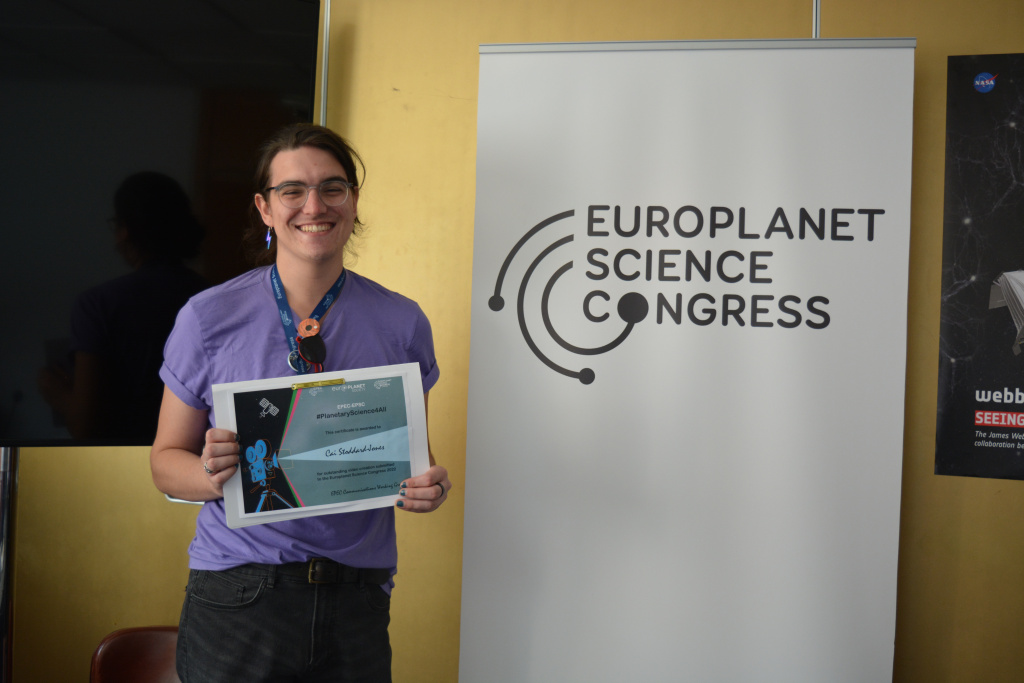
Get involved in the Europlanet Early Career(EPEC) Network! Find out more.
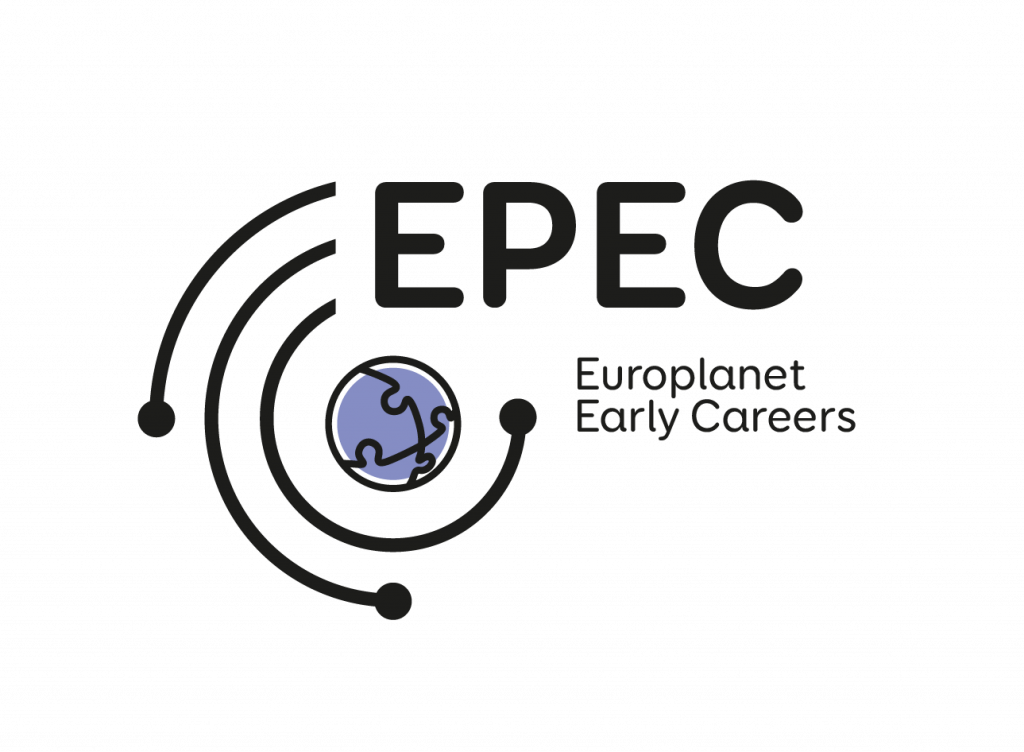

Save the Date!
Read article in the fully formatted PDF of the Europlanet Magazine.
ERIM 2023
The first Europlanet Research Infrastructure Meeting (ERIM) will take place from 19-23 June 2023 in hybrid format at the Hotel Sorea, Bratislava, Slovakia, and online.
ERIM 2023 will bring together a range of planetary science and Europlanet community workshops, including interactive sessions on geological mapping, planetary space weather, the VESPA planetary virtual observatory, the Europlanet Telescope Network, industry engagement, and innovations in outreach tools. The Europlanet Early Career (EPEC) Annual Week will be co-hosted with ERIM 2023, along with Europlanet Society meetings of the Regional Hubs and the Europlanet General Assembly.

DPS-EPSC Joint Meeting 2023
The Europlanet Science Congress (EPSC) 2023 will take place as a joint meeting with the American Astronomical Society’s Division of Planetary Sciences (DPS) at the San Antonio Marriott Rivercenter, San Antonio, Texas, USA, from 1-6 October 2023.

EPSC-DPS Joint Meeting 2025 and EPSC2026
The call for the venues for EPSC-DPS Joint Meeting 2025 and EPSC2026 will open in January 2023 . Submissions from prospective Local Organising Committees in Europe are welcomed. Priority will be given to locations that have not hosted EPSC before, especially in central, east and south-east Europe .

Community News
Incoming Chair of Northern Europe Regional Hub
Read article in the fully formatted PDF of the Europlanet Magazine.
Harri Haukka is Development Manager in the Space Research and Observation Technologies Unit at the Finnish Meteorological Institute (FMI).He has worked on space projects and missions as a systems engineer and project manager, including the development of humidity and pressure instruments for NASA’s Curiosity and Perseverance missions and ESA’s ExoMars Rosalind Franklin rover.
He has been involved in networking activities of Europlanet research infrastructure programmes since 2015, served in various roles on the EPSC Committee, including Co-Chair, and has acted as Industry and Policy Officer for the Northern Europe Regional Hub since 2019.
He now follows Jon Merrison as Hub Chair.

Read article in the fully formatted PDF of the Europlanet Magazine.
Incoming Chair of Spain-Portugal Regional Hub
Alejandro Cardesín Moinelo is a planetary scientist and science operations engineer working for the European Space Agency, specialising in Solar System missions. He is currently focused on Mars exploration, and acts as the manager of the Mars Express mission science ground segment, in coordination with ExoMars and other international projects. Since 2017, he has been the coordinator of the Spanish Planetary Science and Solar System Exploration Community, supporting and promoting collaboration between research and technology institutions and industries in Spain. Alejandro is now taking on the role of Chair of the Spain-Portugal Regional Hub from the inaugural Chair, Miguel Angel López-Valverde.

Read article in the fully formatted PDF of the Europlanet Magazine.
Incoming Chair of Italy Regional Hub
Stavro Ivanovski is a researcher at INAF-Trieste and an adjoint professor at the University of Trieste. His research focuses on small bodies and planetary magnetospheres in the Solar System. Stavro is involved in a number of planetary missions, including LICIACube, Rosetta, BepiColombo, Comet Interceptor, Hera, and Ariel. As a trained actor with theatre experience, he has a strong commitment to public engagement and outreach. Since 2020, Stavro has been the Co-Chair of the Europlanet Science Congress (EPSC) Scientific Organising Committee (SOC). He now takes on the role of Chair of the Italian Regional Hub from Maria Cristina De Sanctis.

Read article in the fully formatted PDF of the Europlanet Magazine.
Incoming Chair of Southeast Europe Regional Hub
Nick Sergis is the incoming Chair of the Southeast Regional Hub, taking over from Ioannis Daglis, who has served in the role since 2019. Nick is Chief Executive Officer of the Hellenic Space Center, which coordinates public entities and co-manages national programs in all space sectors in Greece. His research interests include space and planetary physics, magnetospheric data analysis with emphasis on the outer planets and their moons, magnetosphere-ionosphere coupling, and solar wind dynamics. He was a member of the Cassini Magnetosphere Imaging Instrument (MIMI) Scientific Team. Between 2006 and 2020 he worked at the Office of Space Research and Technology at the Academy of Athens in collaboration with JHU/APL. Since 2017, he has been an Adjunct Researcher at the National Observatory of Athens.

Read article in the fully formatted PDF of the Europlanet Magazine.
We need you!
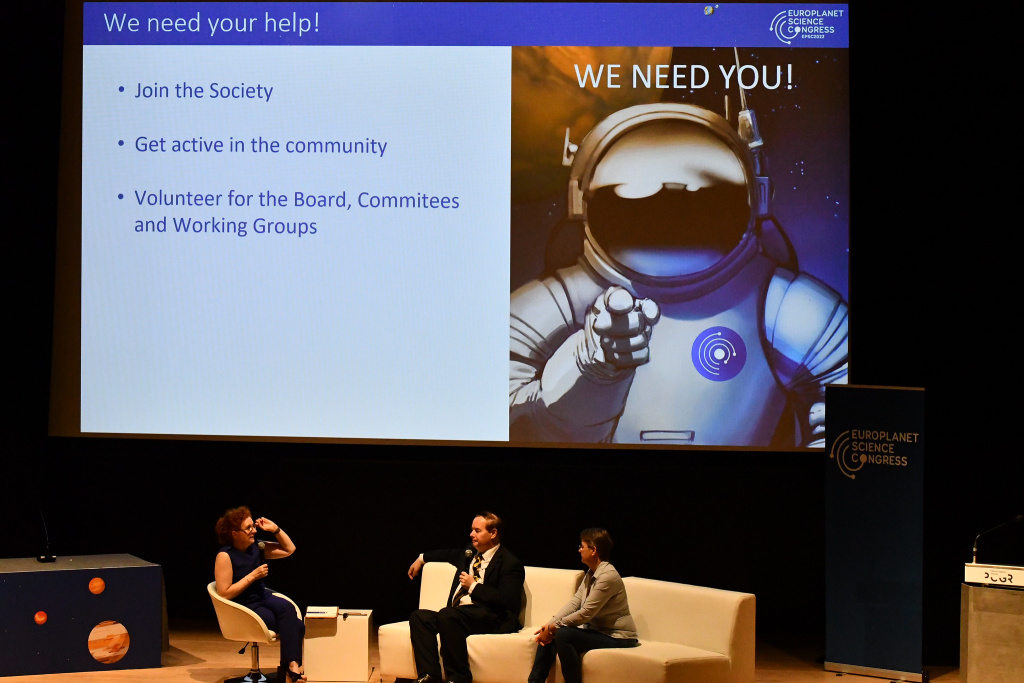
We are looking for volunteers to take on other roles in the Regional Hubs and Committees. Find out more.

Read article in the fully formatted PDF of the Europlanet Magazine.
Wiki-Edit-a-Thon
The third EPSC Planetary Science Wiki-Edit-a-Thon kicked off with a training session ahead of the Icebreaker event on Sunday 18 September and continued throughout the week of EPSC2022 in a dedicated booth in the exhibition hall. The Keynote Diversity Lecture, ‘Let’s talk about women astronomers and Wikipedia’, was delivered by Mentxu Ramilo Araujo, a member of Wikimujeres and Wikimedia España, and highlighted some inspiring efforts to create a diverse and egalitarian Wikipedia in which women are not part of a minority. New results from the Wiki-Edit-a-Thon include over 70 biographies translated by WikiEmakumeok into Basque. Other participants contributed four new translations into Italian, two into German and six new articles in Azerbaijani.

Read article in the fully formatted PDF of the Europlanet Magazine.
Conference on Variable Star Research
Read article in the fully formatted PDF of the Europlanet Magazine.
The 54th Variable Star Research Meeting took place on 25-27 November 2022 in hybrid format online and hosted by the Planetarium Ostrava in the Czech Republic. The meeting, which was organised by the Variable Stars and Exoplanet Section of the Czech Astronomical Society (VSES CAS), attracted 85 participants and included presentations on DART and exoplanet missions. High school and university students were also invited to present their work. Recordings of the talks have been uploaded to the YouTube channel of VSES CAS, with presentation files accessible on the meeting website. Papers from the meeting will be published in Open European Journal on Variable Stars.
https://bit.ly/54VariableStarMeeting

Read article in the fully formatted PDF of the Europlanet Magazine.
The Moons Symphony
Read article in the fully formatted PDF of the Europlanet Magazine.
The Moons Symphony is an orchestral and choral work inspired by moons in our Solar System that has been created by the award-winning Australian composer, Amanda Lee Falkenberg. Earlier this year, the world premiere of The Moons Symphony was recorded by the London Symphony Orchestra, conducted by Marin Alsop, with the London Voices Choir conducted by Ben Parry. The recording has now been released by Signum Classics, featuring the seven-movement work, as well as ‘Clair de Lune’ by Claude Debussy, performed by Amanda on piano, and her poem, ‘Reflections on Symphonic Space Flight’, read by the NASA astronaut, Nicole Stott.
Attendees of the EPSC-DPS Joint Meeting 2019 in Geneva may remember that Amanda previewed some of the movements during the conference and spoke about her research and incorporation of planetary concepts into the musical structure.
https://www.moons-symphony.com/

Read article in the fully formatted PDF of the Europlanet Magazine.
EANA Election
The European Astrobiology Network Association (EANA) has elected its new Executive Board. The incoming President is Jean-Pierre de Vera, with Rosa De La Torre Noetzel and Lena Noack as Vice Presidents, Ruth- Sophie Taubner and Séverine Robert as Secretaries, Frédéric Foucher as Treasurer, and Silvana Pinna as the early career AbGradE representative. http://www.eana-net.eu

Read article in the fully formatted PDF of the Europlanet Magazine.
Journey to the Planets
‘Journey to the Planets’, the winning proposal of this year’s Europlanet Funding Scheme for Public Engagement, aims to inspire children’s curiosity about space and planetary sciences through play and puppet theatre.
Conceived and developed by a team led by Katia Pinheiro, the project is producing a series of short planetary-themed movies. The stories are told by puppets in ‘Bimbim’s team’, a group of animals led by Bimbim the dog. The scientific content of the videos will be supplemented with illustrations and animations about planets in the Solar System, with a particular focus on Earth and Mars.
‘Journey to the Planets’ brings researchers from Germany, Macedonia, India, Argentina and the UK together with a producer and theatre companies from Brazil. The videos will be translated into several languages (initially Portuguese, English and French) to reach out to audiences around the world.
